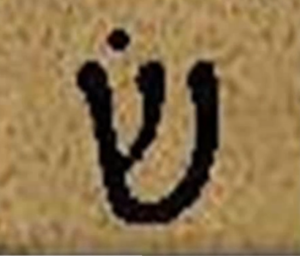
There is a quote that is attributed to many, “sometimes when you’re looking for an answer, you search everywhere else before you take a look at what’s right in front of you.” For many centuries, theologians, archaeologists and historians have pondered what God meant in passages such as this:
“And he built altars in the house of the Lord, of which the Lord said, In Jerusalem will I put My name.” (2nd Kings 21:4)
Not only does God say He has put His name in Jerusalem but this is this repeated in verse 7, and also Ezra 6:12, 2nd Chronicles 6:6; 33:4, 1st Kings 11:36 and 1st Kings 14:21. And there are other Scriptural passages where this is sounded. Was this something to be discovered in an ancient scroll or archaeological site? Is this a reference to the Temple? What did God mean by saying that He would put His name in Jerusalem?
There are 22 letters in the Hebrew alphabet and each letter has a specific meaning and a numerical number attached to it. The 21st letter is “שׁ SHIN” and pronounced “sheen.” It looks somewhat like an English “w” and it is in the same form in Hebrew and in Aramaic/Syriac, a text used in both the Old and the New Testaments. In gematria Shin has the numerical value of 300.
For Jews, Shin ש is the letter that is used to denote the unspeakable name of “HaShem” or “The Name.” It is also the letter that represents “Shaddai” or “El Shadai,” another name for Yahweh.
| “The ש [Shin] stands high among the Sacred Letters because it represents two Names of God: … the All-Sufficient, Unlimited One and … Peace.” (The Wisdom in the Hebrew Alphabet, Rabbi Michael L. Munk, (c)1998, p. 207.) |
In Israel and Jewish homes throughout the world it is common for a “mezuzah” or prayer box to be mounted on the doorpost of homes and businesses. The letter Shin ש is imprinted on every Jewish mezuzah and what is contained within the prayer box is the Scriptural portion of Deuteronomy 6:4 known as “The Shema” in Hebrew, meaning “To Hear.”
“Hear, O Israel: The Lord our God is one Lord.” (Deuteronomy 6:4)
With the advent of aerial photography, satellite imagery and topographical maps there is a remarkable view that unfolds when one looks upon Jerusalem from a higher vantage point. In fact, what is portrayed can even be seen in many map inserts of Bibles.
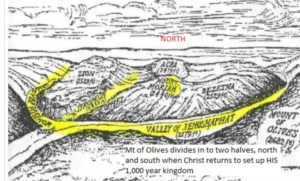
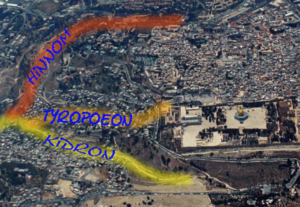
Photo by BiblePictureLibrary.com
There are three significant valleys that make up the city of Jerusalem, two that flank its outskirts and one that runs near the center of the city. These are the Kidron Valley, the Hinnom Valley and the Tyropean Valley. When one views this on a map it marks the outline of a perfect Hebrew Shin ש. It is the Name of God in Hebrew.
When King David first conquered this area and settled it as his capital city, he would have had no idea that this city was seated on the Name of God. “Since the day that I brought forth my people out of the land of Egypt I chose no city among all the tribes of Israel to build an house in, that my name might be there; neither chose I any man to be a ruler over my people Israel: But I have chosen Jerusalem, that my name might be there; and have chosen David to be over my people Israel.” (2nd Chronicles 6:5-6)
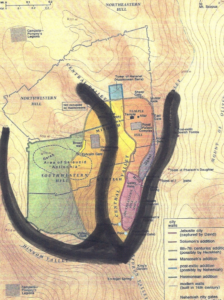
Today, this information is now commonly presented to tourists in sky tours or in scale models of Jerusalem. But the remarkable geographic phenomenon of Jerusalem does not end with the Shin ש.
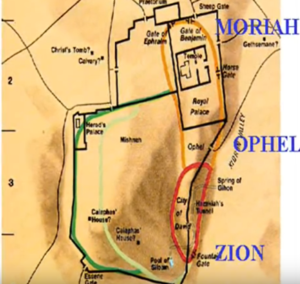
Map by Carl Gallups
The city of Jerusalem is also made up of three mountain heads comprising one mountain known as Zion and is why Jerusalem is referred to as “Zion” or the “City of Zion.” But Zion certainly has three heads, the uppermost head is called Moriah, the center head is called Ophel, and the bottom head of the mountain is called Zion. One mountain, with three distinct heads.
It is a topographical depiction of the Christian Trinity, One God as Three distinct Persons. But there is more. These three mountain names have three significant underlying meanings yet their significance could not have been known thousands of years ago prior to the revelation of Jesus Christ and the New Testament.
In Hebrew, the word Ophel means “my fortress, tower, strong hold.”(Strongs #H6076) All of these are names for Yahweh, God the Father as described in the Old Testament, especially in the Psalms.
Zion means “the mark, the sign, the waymark, the pillar.” (Strongs #H6725) We are reminded that in Ephesians 1:13 Paul states that the Gentiles were included in the family of God, “Having believed, you were MARKED in him with a SEAL, the promised Holy Spirit.” It is the Holy Spirit that is the seal or “mark” on every born-again believer.
Mount Moriah means “to see God or to be seen of God.” (Strongs #4179). In Genesis 22 Moriah is where Abraham took his only begotten son Isaac as a sacrifice before the Lord intervened and provided the sacrifice Himself, a ram caught in the thicket. It is here that the Temple Mount exists today and within this story is the Biblical typology pointing to God’s only begotten Son who would one day be our sacrificial Lamb. And it is in Jesus Christ, when we are able to see God in the flesh.
Ophel- “My Fortress”- God the Father
Moriah- “To see God”- God the Son
Zion- “The Mark”- God the Holy Spirit
When God declared that Jerusalem was where He had place His name, He meant it literally. The very valleys comprising the city declares His name. The mountains that His city sits upon literally cries out His name.
Maybe this is what Jesus was referring to during the last week of His life before the Crucifixion:
“Then, as He was now drawing near the descent of the Mount of Olives, the whole multitude of the disciples began to rejoice and praise God with a loud voice for all the mighty works they had seen, saying: “ ‘Blessed is the King who comes in the name of the Lord!’ Peace in heaven and glory in the highest!” And some of the Pharisees called to Him from the crowd, “Teacher, rebuke Your disciples.” But He answered and said to them, “I tell you that if these should keep silent, the stones would immediately cry out.”(Luke 19:37-40)
God’s word is perfect and infallible. And God’s Name is not just written in the land of Israel, but physically on our hearts! All of humanity has the undeniable mark of God’s creation but each of us must choose whether to give our hearts totally to Him or not. When we give our lives to Christ then we receive His mark upon us, the seal of the Holy Spirit. The beautiful aspect of this is, when the enemy comes against us, God tells him, “You can’t have them because My name is written there! He/She belongs to Me.”
“O Clap your hands, all ye people; shout unto God with the voice of triumph. Sing praises to God, sing praises: sing praises unto our King, sing praises. For God is the King of all the earth: sing ye praises with understanding. (Psalm 47:1,6-7)
There is no one like Him. Has God left His mark on you?
Sources: Michael Munk, Carl Gallups, Dr. J. Stark, Heather Hampton